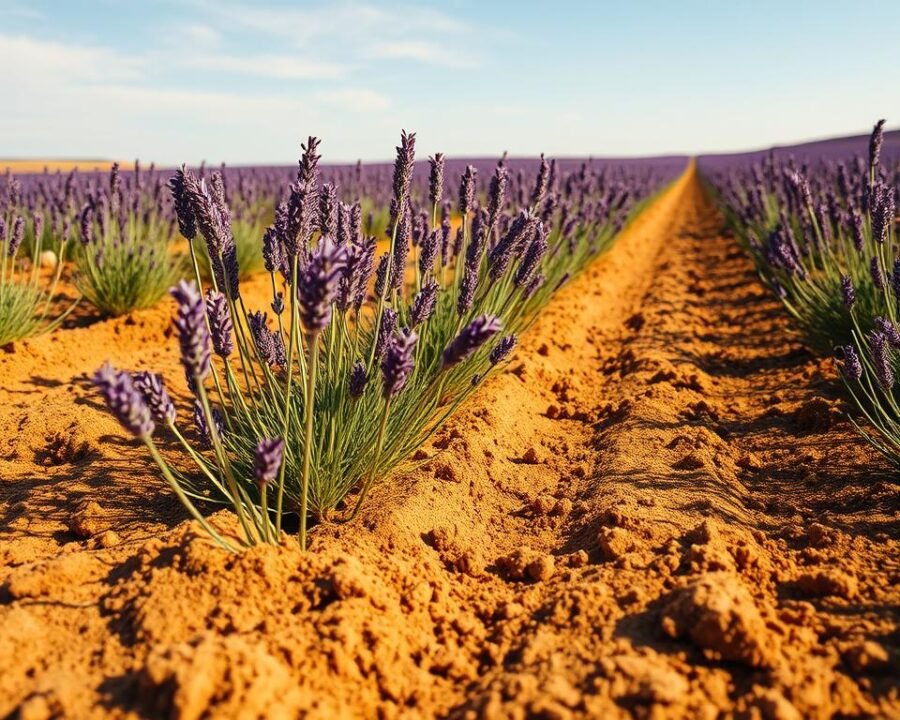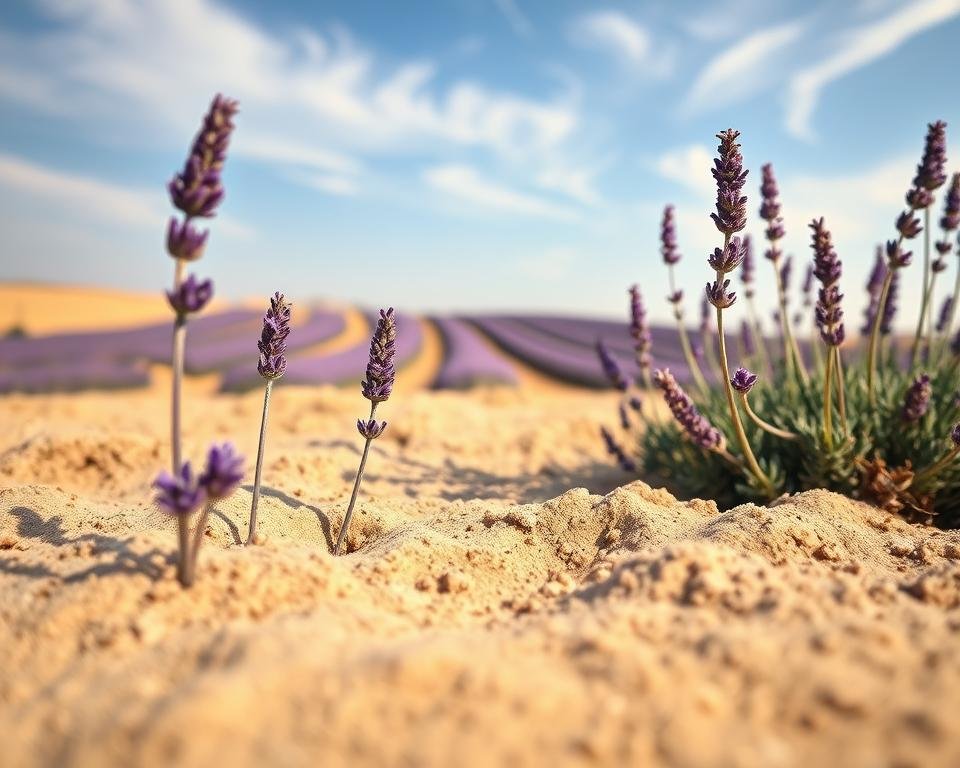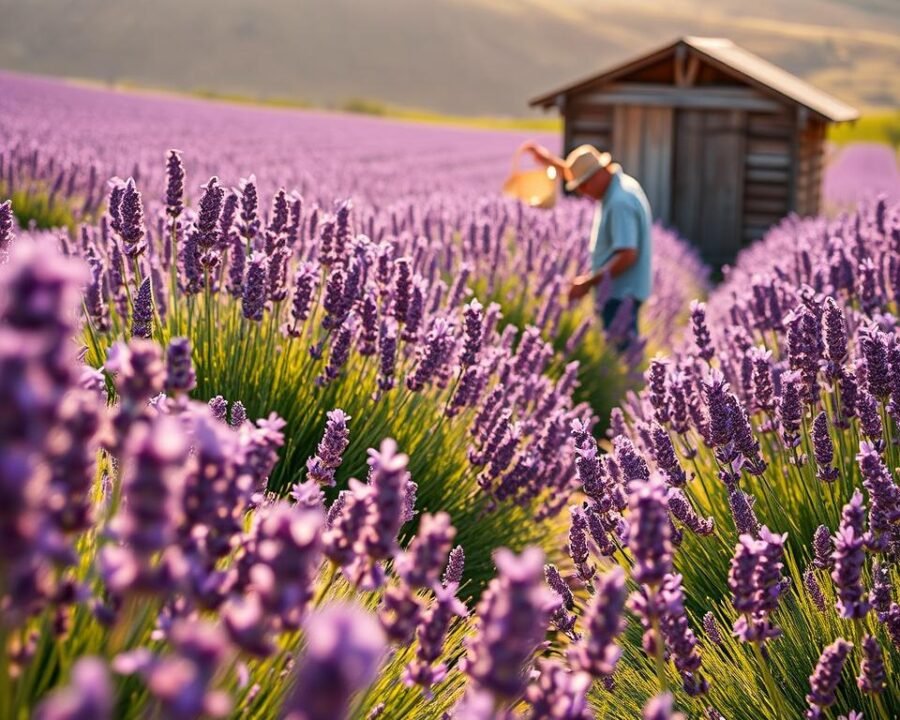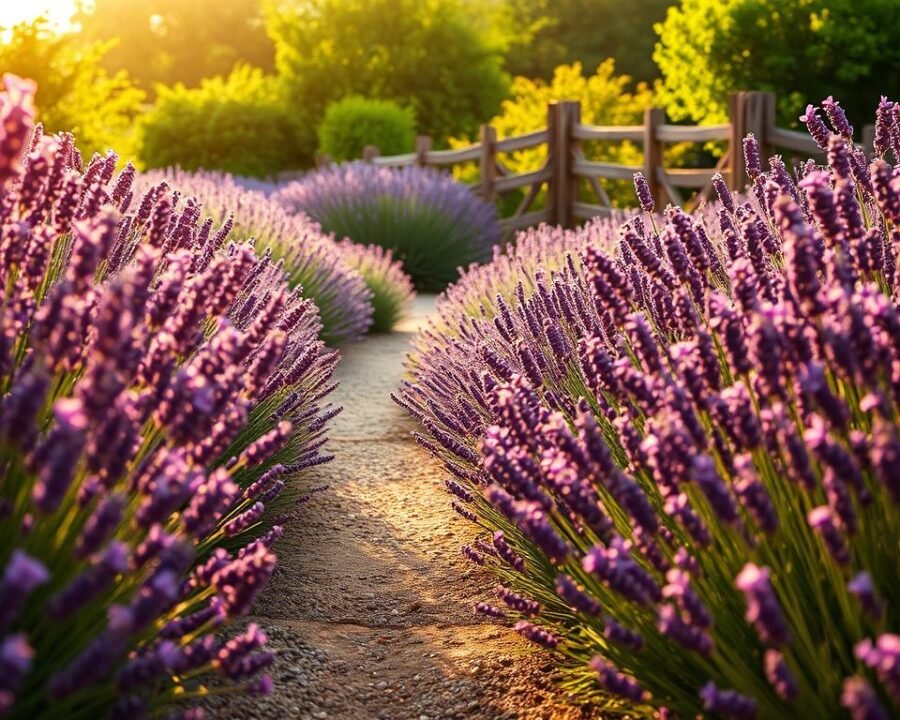There’s something magical about stepping into a garden filled with fragrant blooms. The soothing scent, the vibrant purple hues—lavender brings both beauty and tranquility to any space. Whether you’re dreaming of a backyard oasis or a small windowsill display, this versatile herb can transform your surroundings.
At our core, we believe gardening should be joyful and accessible. That’s why we’re here to guide you through the journey of cultivating lush, thriving lavender. From selecting the right variety to mastering simple care tips, we’ll help you create a stunning display with ease.
Perfect for beginners and seasoned gardeners alike, this low-maintenance plant rewards patience with bursts of color and fragrance. Together, let’s explore the secrets to nurturing healthy, vibrant blooms that last season after season.
Key Takeaways
- Lavender adds beauty and relaxation to gardens and homes.
- Choosing the right variety ensures success in different climates.
- Proper planting and care lead to abundant, fragrant blooms.
- This herb thrives with minimal effort, ideal for all skill levels.
- Creative uses extend beyond the garden, from decor to wellness.
Why Lavender Is the Must-Have Herb for Your Garden
Few plants blend beauty and function like lavender does. Its silvery-green foliage and vibrant purple flowers make it a standout in any garden, while its soothing scent and ecological perks add unmatched value.
Fragrance and Relaxation Benefits
Lavender’s fragrance isn’t just pleasant—it’s therapeutic. Studies show its aromatic compounds reduce stress and anxiety. Here’s how it works:
- Essential oils from the flowers are used in aromatherapy to promote calmness.
- Dried bundles freshen closets or linen drawers naturally.
- Homemade sachets or sprays bring serenity to bedrooms.
Attracting Pollinators and Biodiversity
This versatile herb is a magnet for bees, butterflies, and other pollinators. A single patch can:
- Boost local ecosystems by supporting endangered bee populations.
- Outperform many common garden plants in nectar production.
- Create a buzzing hub of activity, especially in summer.
Whether you’re crafting a sanctuary or nurturing nature, lavender’s blooms deliver on every front.
Choosing the Right Lavender Variety for Your Garden
Not all lavender plants thrive under the same conditions. The key to success lies in matching the variety to your climate and goals. From fragrant flowers to oil-rich stems, each type offers unique perks.
English Lavender (Lavandula angustifolia)
Perfect for cooler regions, this herb boasts sweet-scented blooms and cold hardiness. Popular cultivars like ‘Hidcote’ and ‘Munstead’ flourish in USDA zones 5–8.
- Culinary star: Its mild flavor enhances teas and desserts.
- Compact growth: Reaches 1–2 feet tall, ideal for borders.
- High oil content: A top choice for aromatherapy products.
French and Spanish Lavender Varieties
These Mediterranean natives love heat and well-drained soil. French types (Lavandula dentata) feature serrated leaves, while Spanish flowers sport whimsical “rabbit-ear” bracts.
- Lavandin hybrids: Crosses like ‘Grosso’ excel in oil production.
- Longer bloom season: Flowers appear from spring to fall.
- Best for zones 8–10: Tolerates humidity better than English types.
For arid regions, Spanish lavender plants like ‘Anouk’ thrive with minimal water. In contrast, French varieties add texture to container gardens with their fern-like foliage.
When and Where to Plant Lavender for Success
Timing and location make all the difference when nurturing vibrant lavender. Whether you’re starting from seeds or transplants, strategic choices ensure robust growth and fragrant blooms.
Ideal Planting Season
Spring and early fall are prime times to plant lavender. Avoid winter frosts, which can harm young roots. Here’s a quick guide by USDA zone:
| USDA Zone | Best Time | Frost Considerations |
|---|---|---|
| 5–6 | Late spring | Wait 2 weeks after last frost |
| 7–8 | Early spring or fall | Mulch for insulation |
| 9–10 | Fall | Shield from extreme heat |
- Test soil pH (6.7–7.3) with a kit from garden centers.
- Protect seedlings with cloches if late frost surprises.
Sunlight and Soil Essentials
Lavender craves sunlight—6–8 hours daily. In urban spaces, reflective surfaces like white walls boost exposure. Well-draining soil prevents root rot. Consider these options:
- Raised beds: Enhance drainage in clay-heavy areas.
- In-ground planting: Ideal for sandy or rocky soil.
- Microclimates: South-facing slopes warm faster in spring.
With the right season and conditions, your lavender will reward you with resilience and beauty.
How to Grow Lavender Herb Plant Everyone Is Using
Lavender rewards careful planning with lush growth and fragrant flowers. Focus on these three steps to set the stage for success.

Step 1: Preparing the Soil for Drainage
This herb despises wet feet. Mix builder’s sand or gravel into native soil at a 1:1 ratio. For heavy clay, raised beds or mounds boost drainage instantly.
- Test pH: Aim for 6.7–7.3 with a kit from garden centers.
- Organic matter: Limit compost to 10%—too much retains moisture.
Step 2: Planting Techniques for Healthy Roots
Gently loosen the roots before placing transplants. Dig holes twice as wide as the root ball but no deeper. Backfill with your sandy mix, pressing lightly to eliminate air pockets.
For pots, use a gritty cactus mix. Planting lavender in containers? Ensure holes at the bottom prevent waterlogging.
Step 3: Spacing for Optimal Air Circulation
Give plants room to breathe—space them 12–18 inches apart. Crowding traps humidity, inviting mold. In humid climates, stretch to 24 inches for good air flow.
- Rows: Align north-south for even sun exposure.
- Container tip: Single plants per 12-inch pot thrive best.
With the right start, your lavender will establish quickly, resisting rot and pests.
Watering Lavender: Less Is More
Mastering lavender care means understanding its dislike for soggy conditions. These Mediterranean natives prefer dry feet over damp roots, making proper hydration a delicate balance.
Finding the Sweet Spot
Check soil moisture by inserting a finger 2 inches deep. If it feels cool or damp, hold off on water. For precision, use a moisture meter from garden centers.
| Climate Type | Weekly Water | Special Notes |
|---|---|---|
| Arid/Dry | 1 inch | Morning watering reduces evaporation |
| Humid | 0.5 inch | Watch for fungal issues |
| Container | 1.5 inches | Ensure pot drainage holes |
When Too Much Becomes Harmful
Yellowing leaves often signal overwatering. Other warnings include:
- Wilting despite wet soil
- Blackened roots when gently uprooted
- Musty odor from the base
“Lavender would rather endure drought than drown—its survival instinct favors dry resilience.”
Revive overwatered plants by:
- Reducing irrigation immediately
- Improving drainage with sand or perlite
- Trimming affected leaves
Rainwater works best for lavender plants, as tap water’s minerals can accumulate. Collect it in barrels during wet seasons for summer use.
Soil and Fertilizer Tips for Thriving Lavender
The secret to vibrant lavender lies beneath the surface—its soil. Unlike many garden favorites, this resilient plant thrives in lean, well-drained earth. Getting the mix right ensures stronger stems, richer fragrance, and abundant blooms.

Balancing the Perfect pH
Lavender prefers slightly alkaline conditions (6.7–7.3 pH). Test kits from garden centers make checking easy. For acidic soil, mix in lime at 1 cup per square foot. Sandy areas may need sulfur to lower pH.
Signs of imbalance include:
- Yellow leaves (often too acidic)
- Stunted growth (extreme alkalinity)
The Organic Matter Debate
While compost benefits most plants, lavender suffers with more than 10% organic content. Excess humus retains moisture and dulls fragrance. Instead, amend with:
- Coarse sand (50/50 mix for clay soil)
- Crushed gravel for drainage
- Light dusting of wood ash for potassium
| Fertilizer Type | Pros | Cons | Best For |
|---|---|---|---|
| Miracle-Gro® Performance Organics® | Slow-release nutrients | Higher cost | Container plants |
| Bone meal | Boosts root growth | Attracts animals | New plantings |
| Fish emulsion | Quick green-up | Strong odor | Early spring recovery |
Spot nutrients deficiencies early. Purple-tinged leaves often need phosphorus, while weak stems crave potassium. Foliar sprays with seaweed extract offer quick fixes without overloading the soil.
Pruning and Maintenance for Longevity
Keeping your lavender looking its best requires simple yet strategic care. Proper pruning extends the plant’s life while encouraging lush growth and abundant flowers. With the right techniques, you’ll enjoy vibrant blooms year after year.
When and How to Prune
Timing matters for healthy stems. The best time to prune is right after the first flowering fades, typically in late spring or early summer. This allows new growth to harden before winter.
Follow these steps for success:
- Use sharp, sterilized shears to prevent disease spread.
- Cut back about one-third of the stems, just above a set of leaves.
- Remove dead or woody branches at the base.
For older plants, rejuvenation pruning works wonders. In early spring, cut back up to half the plant’s height. This drastic way stimulates fresh, vigorous shoots.
Encouraging Bushier Growth
Strategic cuts create fuller plants. Focus on nodes—the small bumps where leaves meet stems. Pruning just above these points directs energy to multiple new branches.
Key tips for density:
- Pinch back young plants to promote branching.
- Space cuts evenly around the plant for balanced growth.
- Avoid cutting into old wood, as it may not regrow.
For winter care, a light trim in fall prevents snow damage. Leave some flowers for visual interest and bird food. Come spring, your lavender will reward this care with renewed vitality.
Like pruning roses, lavender benefits from clean tools and precise cuts. A few minutes of seasonal attention keeps plants thriving for decades.
Growing Lavender in Pots: A Beginner’s Guide
Container gardening opens new possibilities for enjoying lavender’s charm in small spaces. Whether you’re working with a balcony or windowsill, the right pot and conditions make all the difference. We’ll help you navigate soil choices, placement, and seasonal care for thriving blooms.
Choosing the Right Container
Material matters for healthy roots. Terracotta breathes better than plastic, reducing humidity around roots. For hot climates, light-colored pots reflect heat.
| Pot Type | Pros | Cons | Best For |
|---|---|---|---|
| Terracotta | Natural air flow | Heavy; dries fast | Outdoor use |
| Plastic | Lightweight | Traps moisture | Indoor settings |
| Fabric | Superior drainage | Less durable | Temp control |
Size guidelines:
- 12-16″ diameter for mature plants
- 5-gallon minimum for root space
- Deeper than wide to accommodate taproots
Indoor vs. Outdoor Potting Tips
Outdoor potting thrives with morning sun and afternoon shade. Use cactus mix blended with perlite for drainage. Indoor plants need:
- South-facing windows (6+ hours light)
- Weekly rotation for even air exposure
- 60-75°F daytime temps
Winter care differs by location. In cold zones, move pots indoors before frost. Reduce watering when humidity rises. A gravel layer beneath containers improves conditions year-round.
Common Lavender Pests and How to Avoid Them
Even resilient plants face challenges from tiny invaders. Recognizing early signs of trouble helps protect your lavender’s vibrant leaves and blooms. With simple care strategies, you can prevent most issues before they escalate.
Aphids and Spider Mites
These tiny pests cluster on new growth, sucking sap and weakening plants. Look for curled leaves or sticky residue. Combat them naturally:
- Spray with neem oil every 7 days (mix 1 tsp per quart of water)
- Wipe leaves with homemade insecticidal soap (1 tbsp dish soap + 1 quart water)
- Introduce ladybugs—they devour 50+ aphids daily
“Healthy lavender naturally resists pests—stress from overwatering or poor soil invites trouble.”
Preventing Fungal Diseases
High humidity fosters mold and rot. Pebble mulch around stems improves airflow while absorbing excess moisture. Key prevention tips:
| Disease | Signs | Solution |
|---|---|---|
| Botrytis | Gray fuzzy spots | Remove infected stems + copper fungicide |
| Root Rot | Wilting + black roots | Repot in gritty mix; reduce watering |
Boost defenses through smart planting. Rosemary and sage nearby repel beetles, while marigolds deter nematodes. For severe cases, organic fungicide sprays offer effective treatment without harsh chemicals.
Morning watering routines keep humidity low. Space plants properly—crowding traps damp air. With these steps, your lavender stays lush and pest-free the whole season.
Harvesting Lavender for Maximum Fragrance
Capturing lavender’s peak aroma requires perfect timing and technique. When handled correctly, those purple blooms retain their signature scent for months. We’ll guide you through the ideal time to harvest and preservation methods that lock in freshness.
Spotting the Perfect Harvest Window
For intense fragrance, cut lavender when buds show color but before flowers fully open. This stage captures peak essential oils. Watch for these signs:
- 1/3 to 1/2 of buds on stems display color
- Lower buds slightly more developed than tips
- Morning dew has evaporated but before midday heat

Dry weather is ideal—humidity reduces oil concentration. Use sharp snips to cut stems 6-8 inches long, leaving greenery for regrowth. Bundles of 50-100 stems dry most evenly.
Preserving Color and Scent
Traditional methods yield the best results for long-term storage. Compare these approaches:
| Method | Duration | Color Retention |
|---|---|---|
| Hanging upside-down | 2-3 weeks | Excellent |
| Drying racks | 1-2 weeks | Good (flip daily) |
“Darkness preserves lavender’s vibrant hues—a closet or pantry works better than sunny windows.”
For storage, airtight glass jars beat plastic. Add silica packets to control moisture. Label batches with harvest dates and varieties for easy identification. Properly dried lavender maintains potency for 2-3 years when kept in cool, dark conditions.
Whether crafting sachets or saving for tea, this way of processing ensures your harvest delivers lasting enjoyment. Those carefully timed cuts reward patience with intense aromatic blooms that brighten any space.
Creative Uses for Your Homegrown Lavender
Your homegrown lavender offers endless possibilities beyond the garden. This versatile herb transforms into culinary delights, soothing skincare, and charming decor. Let’s explore ways to enjoy those fragrant flowers in everyday life.
Culinary Creations
Lavender adds floral elegance to dishes when used sparingly. Try these ideas:
- Shortbread cookies: Mix 1 tsp dried flowers into dough for a delicate addition
- Herbal tea blends: Combine with mint stems for relaxing infusions
- Cocktail rimmer: Crush buds with sugar for gin-based drinks
For savory dishes, steep stems in olive oil. This creates a fragrant base for marinades. Remember—English varieties work best as a culinary addition.
DIY Wellness Projects
Harness lavender’s calming fragrance with simple crafts:
- Sachets: Sew small linen bags filled with dried buds
- Bath salts: Mix Epsom salts with 10 drops essential oil
- Pillow sprays: Combine with water in a mist bottle
“Lavender’s scent lingers beautifully in homemade gifts—wrap sachets in muslin with rustic twine for charming presents.”
With these ideas, your garden harvest becomes a source of daily joy. Whether crafting or cooking, lavender’s magic extends far beyond its herb bed.
Companion Plants to Boost Your Lavender’s Health
Strategic plant pairings can transform your lavender’s vitality and beauty. The right neighbors improve soil conditions, deter pests, and create visual harmony. We’ll explore dynamic duos that elevate your garden ecosystem.
Rosemary, Thyme, and Sage
Mediterranean herbs share lavender’s love for sunny, well-drained spots. Their similar needs make them ideal partners. Consider these benefits:
- Root compatibility: Shallow thyme roots won’t compete with lavender’s deeper system
- Drought resistance: All thrive with minimal watering
- Aromatic synergy: Blended scents repel deer and rabbits
For visual appeal, alternate silver-green lavender with darker rosemary. Purple sage creates stunning color contrast. These plants bloom at different times, extending seasonal interest.
Marigolds for Pest Control
Bright marigolds serve as natural bodyguards for lavender. Their strong scent confuses harmful insects while attracting pollinators. Research shows:
| Marigold Type | Pest Deterred | Planting Distance |
|---|---|---|
| French Marigold | Nematodes | 6-12 inches |
| Signet Marigold | Whiteflies | 8-10 inches |
For best results, plant marigolds as a border around lavender patches. Their shallow roots improve soil structure without hindering growth. As an addition, they add cheerful color all season.
These companion strategies create healthier, more productive plants. Whether designing a kitchen garden or ornamental display, thoughtful pairings make every square foot count.
Troubleshooting: Why Isn’t My Lavender Blooming?
When lavender refuses to bloom, the issue often lies in simple growing missteps. We’ll decode the most common culprits—from nutrient overload to light shortages—and share proven recovery strategies. With these fixes, you can transform sparse growth into abundant blooms.
Over-Fertilization Issues
Excess nitrogen pushes leafy growth at the expense of flowers. Test your soil if plants look lush but bloomless. Ideal conditions show these levels:
| Nutrient | Optimal Range | Deficiency Signs |
|---|---|---|
| Nitrogen | 10-20 ppm | Yellow lower leaves |
| Phosphorus | 15-30 ppm | Purple leaf edges |
| Potassium | 100-150 ppm | Weak stems |
For nitrogen-heavy soil, flush with water and add bone meal. This phosphorus-rich fertilizer encourages flowering. Wait 4-6 weeks for improvements—lavender needs time to reset its growth cycle.
Insufficient Sunlight Solutions
Fewer than 6 daily sunlight hours starves energy for blooms. Try these fixes:
- Relocate containers to south-facing spots
- Prune overhanging branches blocking light
- Use reflective mulch to bounce rays upward
“Lavender plants store solar energy like batteries—without full charges, they can’t power flowers.” —Dr. Ellen Voss, Horticulturist
In deep shade, consider transplanting. Spring or fall offers the best time for moving plants. Protect roots with burlap during transfer, and water deeply afterward. Most lavenders show renewed flowering within 8 weeks under proper conditions.
Conclusion: Enjoy Your Fragrant, Flourishing Lavender
Your journey with lavender brings beauty and calm to any space. From well-drained soil to mindful pruning, each step ensures vibrant plants. Now, it’s time to explore—craft sachets, brew tea, or share cuttings with friends.
We’d love to hear your success stories! Tag us in photos of your purple blooms. For deeper care tips, check our upcoming guide on winterizing this versatile herb.
Whether in pots or borders, lavender elevates any garden. Its resilience and charm make every effort worthwhile. Happy gardening!
